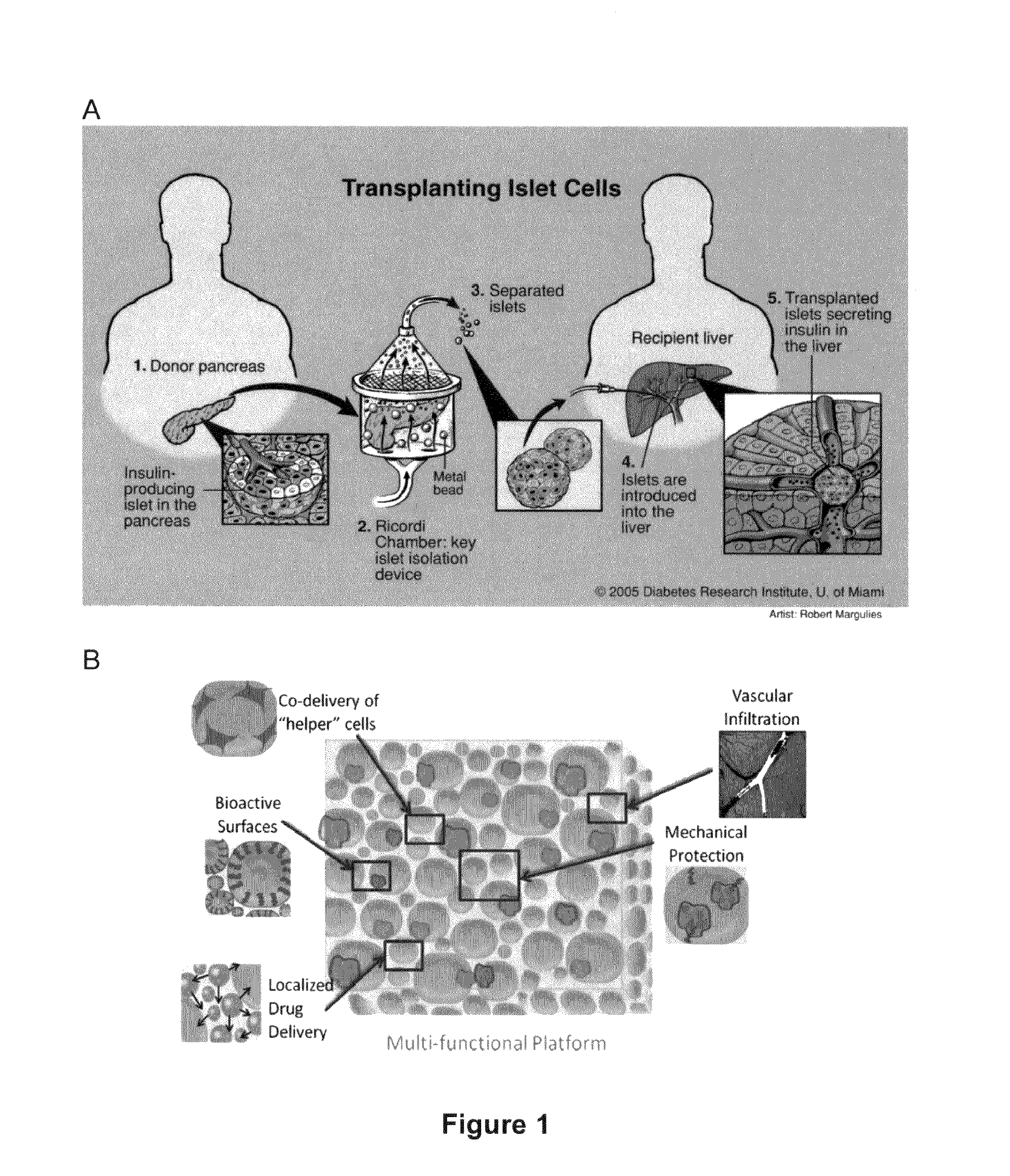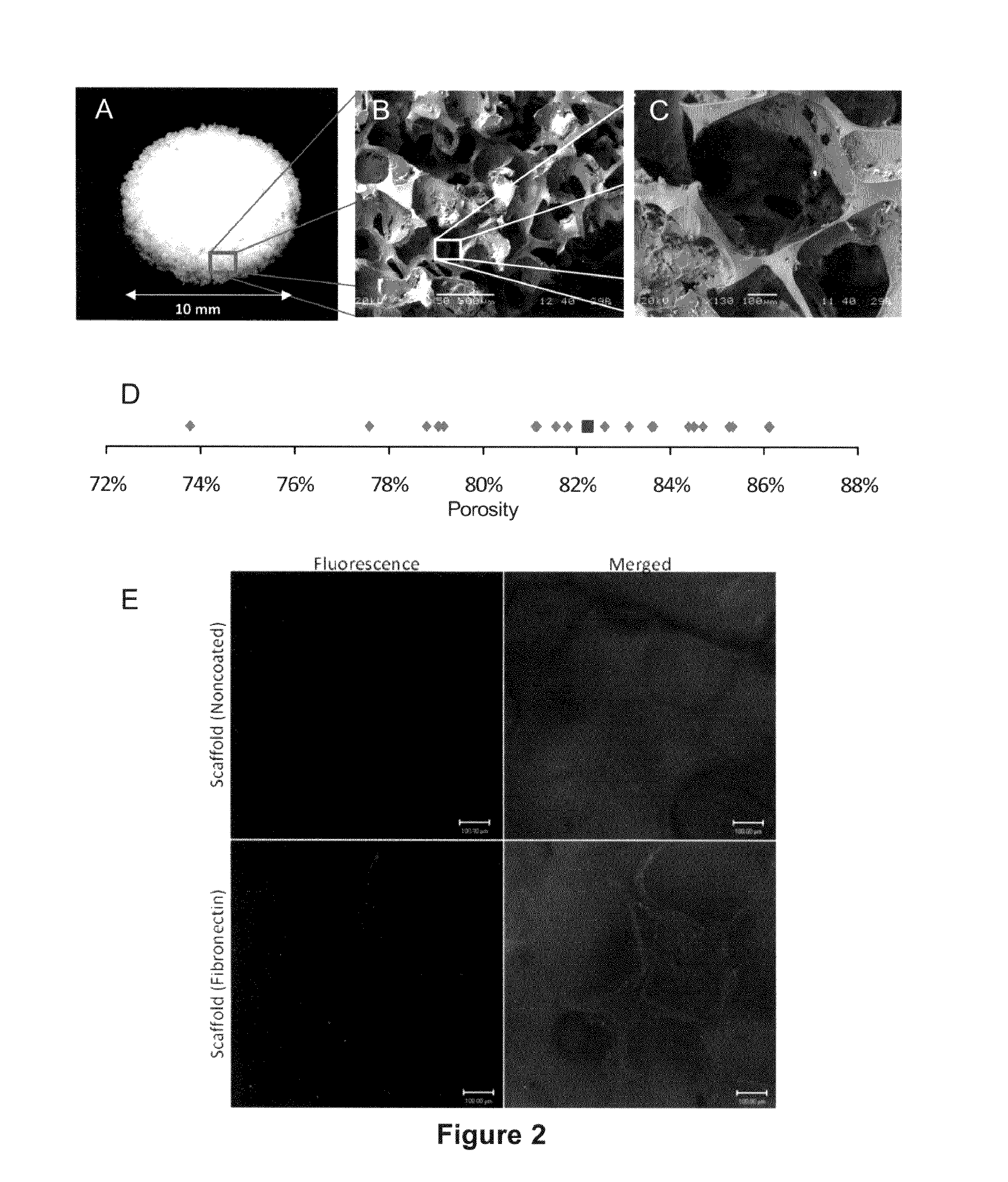Macroporous bioengineered scaffolds for cell transplantation
- Summary
- Abstract
- Description
- Claims
- Application Information
AI Technical Summary
Benefits of technology
Problems solved by technology
Method used
Image
Examples
example 1
Fabrication of Macroporous Silicone Scaffolds
[0079]Macroporous silicone scaffolds were fabricated using the solvent casting and particulate leaching technique (SCPL). The silicone polymer was prepared by mixing PDMS monomer with platinum catalyst, 4:1 v / v. The silicone molds were created by combining varying ratios (50-90% v / v) of sodium chloride crystals (Mallinckrodt Baker, N.J.) (250 to 425 μm diameter) and silicone polymer solution. The salt / silicone mixture was loaded into prefabricated, stainless steel molds (10 mm diameter, 2 mm height), pressurized to 1500 psi and incubated at 37° C. for 48 hrs to complete silicone cross-linking. The NaCl was then leached out from the scaffolds for at least 72 hrs. Pore size and degree of porosity were individually controlled by varying the particle size and polymer to particle ratio, respectively. For enhanced cell adhesion, the scaffold surface was modified by incubating overnight with fibronectin at 250 μg / mL.
example 2
Characterization of Macroporous Silicone Scaffolds
[0080]The macroporous structure of the scaffold was visualized photographically (FIG. 2A) and by scanning electron microscopy (SEM) (FIG. 2B, C). As seen in the SEM images, the scaffold is highly porous and the pore size is representative of the salt crystal diameter. Moreover, the pores are interconnected and tortuous. Final porosity was determined using gross measurements and weights (dry and wet), and calculated with the following formula:
porosity=mw / ρwmw / ρw+msilicone / ρsilicone
Porosity of the scaffolds manufactured with 90% w / v sodium choloride crystals was determined to be 85%±5% w / v (FIG. 2D).
[0081]The protein-modified scaffold surface was stained with anti-fibronectin-biotin primary and streptavidin-FITC secondary antibodies, and visualized through confocal imaging. The fluorescence imaging demonstrated a homogenously modified scaffold surface with protein coating (FIG. 2E).
[0082]We performed in vivo studies to assess biocompat...
example 3
Islet Viability and Function in Macroporous Silicone Scaffolds
[0085]Pancreatic islets from male Lewis rats, non-human primate (NHP) baboons, and human sources were used in experiments to measure islet viability and function in macroporous silicone scaffolds. Islets were loaded into the scaffolds at the desired islet equivalent (IEQ) density by suspending them in a small volume, pipetting them onto the scaffolds and applying a light pressure gradient to distribute the islets into micro-sized pores. Fibrin glue was added to select groups to evaluate islet retention. The islets were cultured in tissue culture dishes at 20% oxygen for up to 24 hours. Two-dimensional cultures were used as controls.
[0086]Scaffolds seeded with rat, non-human primate and human islets were inspected for islet spatial distribution and viability by fluorescent live / dead dye staining (calcein AM and EthD-1) and confocal microscopy (FIG. 9). The adherence of the rat and non-human primate islets, and the viabilit...
PUM
| Property | Measurement | Unit |
|---|---|---|
| Pore size | aaaaa | aaaaa |
| Porosity | aaaaa | aaaaa |
| Pressure | aaaaa | aaaaa |
Abstract
Description
Claims
Application Information
 Login to View More
Login to View More - R&D
- Intellectual Property
- Life Sciences
- Materials
- Tech Scout
- Unparalleled Data Quality
- Higher Quality Content
- 60% Fewer Hallucinations
Browse by: Latest US Patents, China's latest patents, Technical Efficacy Thesaurus, Application Domain, Technology Topic, Popular Technical Reports.
© 2025 PatSnap. All rights reserved.Legal|Privacy policy|Modern Slavery Act Transparency Statement|Sitemap|About US| Contact US: help@patsnap.com



